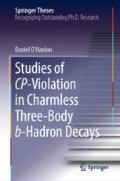Abstract
Multi-body decays of unstable particles proceed, where permitted, via various short-lived intermediate resonant states. To probe the interactions that govern these decays, an understanding of the quantum-mechanical amplitude that describes these process is required. The distributions of the angular components of this amplitude are well known and constrained by angular momentum conservation, which permits the separation of various interfering resonant components of differing spin. Interfering components of the same spin result in complicated distributions in the invariant-mass projections that are not as well understood, and are further complicated by the numerous decay channels opening with increasing invariant-mass.
Access this chapter
Tax calculation will be finalised at checkout
Purchases are for personal use only
Notes
- 1.
For \({{{{B}} ^+}} \!\rightarrow {{\pi } ^+} {{\pi } ^+} {{\pi } ^-} \), the symmetrisation of the amplitude by a folding of the Dalitz-plot results in this only being true at low mass for projection on the low-mass combination of oppositely charged pions (and high mass for the projection on the high-mass combination), as the full helicity range is not integrated over.
- 2.
- 3.
This parameterisation disregards information about additional open channels, and as such its validity, particularly for precision mass measurements or for modelling the higher mass \(\rho (1450)\) and \(\rho (1700)\) resonances, is questioned by some authors [7].
- 4.
This can also be done for neutral meson decays via specific intermediate resonances whose decays are quasi-flavour-specific, such as in the amplitude analysis of the \({{{B}} ^0} \!\rightarrow {{K} ^0_\mathrm{\scriptscriptstyle S}} {{\pi } ^+} {{\pi } ^-} \) decay, where \(C\!P\)-violation was observed in the \({{{B}} ^0} \!\rightarrow {{K} ^{*+}} (892)({{K} ^0_\mathrm{\scriptscriptstyle S}} {{\pi } ^+}){{\pi } ^-} \) decay [23].
References
R.H. Dalitz, S.F. Tuan, The phenomenological description of K-nucleon reaction processes. Ann. Phys. 10, 307 (1960). https://doi.org/10.1016/0003-4916(60)90001-4
J. Blatt, V.E. Weisskopf, Theoretical nuclear physics (Wiley, New York, 1952)
F. von Hippel, C. Quigg, Centrifugal-barrier effects in resonance partial decay widths, shapes, and production amplitudes. Phys. Rev. D 5, 624 (1972). https://doi.org/10.1103/PhysRevD.5.624
Particle Data Group, C. Patrignani et al., Review of particle physics. Chin. Phys. C40, 100001 (2016) (2017 update). https://doi.org/10.1088/1674-1137/40/10/100001
C. Zemach, Three pion decays of unstable particles. Phys. Rev. 133, B1201 (1964). https://doi.org/10.1103/PhysRev.133.B1201
C. Zemach, Use of angular-momentum tensors. Phys. Rev. 140, B97 (1965). https://doi.org/10.1103/PhysRev.140.B97
P. Lichard, M. Vojik, An alternative parametrization of the pion form-factor and the mass and width of RHO(770), arXiv:hep-ph/0611163
G.J. Gounaris, J.J. Sakurai, Finite-width corrections to the vector-meson-dominance prediction for \(\rho \rightarrow {e}^{+}{e}^{-}\). Phys. Rev. Lett. 21, 244 (1968). https://doi.org/10.1103/PhysRevLett.21.244
W.M. Dunwoodie, Omega-RHO mixing parametrization, http://www.slac.stanford.edu/~wmd/omega-rho_mixing/omega-rho_mixing.note
P.E. Rensing, Single electron detection for SLD crid and multi-pion spectroscopy in K\(^{-}p\) interactions at 11 GeV/c. Ph.D. thesis, Stanford University, Stanford, CA, 1993 (Presented on 1993)
CMD-2 Collaboration, R.R. Akhmetshin et al., Measurement of \(e^+e^- \rightarrow \pi ^+\pi ^-\) cross-section with CMD-2 around \(\rho \) meson. Phys. Lett. B527, 161 (2002). https://doi.org/10.1016/S0370-2693(02)01168-1, arXiv:hep-ex/0112031
S. Coleman, S.L. Glashow, Departures from the eightfold way: theory of strong interaction symmetry breakdown. Phys. Rev. 134, B671 (1964). https://doi.org/10.1103/PhysRev.134.B671
D. Aston et al., A study of \(K^-\pi ^+\) scattering in the reaction \(K^-p \rightarrow K^-\pi ^+ n\) at \(11\) GeV/c. Nucl. Phys. B 296, 493 (1988). https://doi.org/10.1016/0550-3213(88)90028-4
S.M. Flatté, Coupled-channel analysis of the \(\pi \eta \) and KK systems near KK threshold. Phys. Lett. B 63, 224 (1976)
V.V. Anisovich, A.V. Sarantsev, K matrix analysis of the (\(IJ^{PC} = 00^{++}\)) -wave in the mass region below 1900 MeV. Eur. Phys. J. A 16, 229 (2003). https://doi.org/10.1140/epja/i2002-10068-x. arXiv:hep-ph/0204328
I.J.R. Aitchison, K-matrix formalism for overlapping resonances. Nucl. Phys. A 189, 417 (1972). https://doi.org/10.1016/0375-9474(72)90305-3
S.L. Adler, Consistency conditions on the strong interactions implied by a partially conserved axial-vector current. II. Phys. Rev. 139, B1638 (1965). https://doi.org/10.1103/PhysRev.139.B1638
Focus Collaboration, J.M. Link et al., Dalitz plot analysis of \(D_{s}^+\) and \(D^+\) decay to \(\pi ^+ \pi ^- \pi ^+\) using the K matrix formalism. Phys. Lett. B585, 200 (2004). https://doi.org/10.1016/j.physletb.2004.01.065, arXiv:hep-ex/0312040
BaBar Collaboration, B. Aubert et al., Improved measurement of the CKM angle \(\gamma \) in \(B^\mp \rightarrow D^{(*)} K^{(*\mp )}\) decays with a Dalitz plot analysis of \(D\) decays to \(K^0_{S} \pi ^{+} \pi ^{-}\) and \(K^0_{S} K^{+} K^{-}\). Phys. Rev. D78, 034023 (2008). https://doi.org/10.1103/PhysRevD.78.034023, arXiv:0804.2089
T. Latham, The Laura++ Dalitz plot fitter, in AIP Conference Proceedings, vol. 1735 (2016) p. 070001. https://doi.org/10.1063/1.4949449, arXiv:1603.00752
F. James, M. Roos, Minuit: a system for function minimization and analysis of the parameter errors and correlations. Comput. Phys. Commun. 10, 343 (1975). https://doi.org/10.1016/0010-4655(75)90039-9
B. Efron, Bootstrap methods: another look at the jackknife. Ann. Stat. 7, 1 (1979). https://doi.org/10.1214/aos/1176344552
LHCb, R. Aaij et al., Amplitude analysis of the \(B^0 \rightarrow K^0_s \pi ^+\pi ^-\) decay (In preparation)
LHCb, R. Aaij et al., Measurement of the \(B^{\pm }\) production asymmetry and the \(CP\) asymmetry in \(B^{\pm } \rightarrow J/\psi K^{\pm }\) decays, arXiv:1701.05501
Author information
Authors and Affiliations
Corresponding author
Rights and permissions
Copyright information
© 2018 Springer Nature Switzerland AG
About this chapter
Cite this chapter
O’Hanlon, D. (2018). Amplitude Analysis. In: Studies of CP-Violation in Charmless Three-Body b-Hadron Decays. Springer Theses. Springer, Cham. https://doi.org/10.1007/978-3-030-02206-8_6
Download citation
DOI: https://doi.org/10.1007/978-3-030-02206-8_6
Published:
Publisher Name: Springer, Cham
Print ISBN: 978-3-030-02205-1
Online ISBN: 978-3-030-02206-8
eBook Packages: Physics and AstronomyPhysics and Astronomy (R0)

